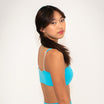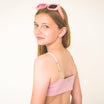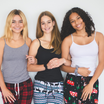Journey Into Womanhood With a Guide on How to Measure for a Training Bra

So, it's time for a bra? Let's get started! We know this can be a big step for both teens and their parents. With so many brands, styles, and sizes out there, it can feel a bit like you're lost in a maze. But don't worry. We're here to give you the lowdown on how to measure for a training bra.
With this handy guide, you'll be able to find the perfect fit for your girl, ensuring they have the support they need during this important milestone in their life.
Training Bra vs. Sports Bra
Before we dive into measurements, it's important to understand the distinction between training bras and sports bras. Although both are created with the comfort of young girls in mind, they serve different purposes and are typically used in different situations.
What Is a Training Bra?

A training bra is typically the first type of bra a young girl will wear. It's a lightweight garment designed for girls who have started developing breasts but don't yet fit into standard-size bras. They are normally simple in design, without underwire or padding, and are made to be easy to wear. The main purpose of these bras is to provide a layer of privacy rather than to offer physical support, which is often not needed at this early stage of development.
Training bras also help young girls become accustomed to wearing a bra and are a gentle introduction to the world of women's undergarments. They offer a sense of maturity and are a sign of growing up, which can be important for their self-esteem and body confidence. Remember, the transition into wearing a bra is a personal journey that should be guided by comfort and readiness, not societal pressure.
What Is a Sports Bra?

A sports bra, on the other hand, is designed to provide a type of reinforcement during physical activity. Regardless of size, breasts can move during exercise, which can sometimes lead to discomfort or even pain. Sports bras help to minimize this movement. They are typically made of stretchy, absorbent materials to wick away sweat, and they often have wider straps and additional coverage to provide extra support.
While a training bra is usually sufficient for daily activities for young girls, a sports bra can be a good investment if your teen is involved in sports or other physical activities. As always, the most important thing is that the bra is comfortable and makes your daughter feel good.
The Importance of Accurate Measurements
It's also really important to understand why getting the right measurements matters so much. A bra that doesn't fit right can cause discomfort, backaches, and even breast pain, which can really affect your girl's day-to-day life and well-being. Plus, each brand has its own sizing chart, which can make things a bit tricky.
But with the right knowledge and tools, you can navigate through it all. Getting the right measurements ensures a perfect fit, giving your tween the boost and encouragement that they need during this big step in their life. Hence, it's not just about physical reassurance but also about helping your daughter feel good about themselves and their body.
A Step-By-Step Guide to Measuring for a Training Bra
Now, we’re ready to measure. So get out your measuring tape, and let’s find a bra that is the ideal fit and makes your daughter feel happy, secure, and at ease.
Band Size
- Have your daughter wear a non-padded bra or no bra at all.
- Wrap a measuring tape around the torso directly under the bust where a bra band would sit. Ensure the tape is level and snug.
- Round the measurement to the nearest whole number.
- If the number is even, add four inches. If it's odd, add five. The result is the band size.
Bust Measurement
- Loosely wrap the measuring tape around the fullest part of the chest (at nipple level).
- Round this measurement to the nearest whole number.
Cup Size
- Subtract the band size from the bust measurement.
- The difference determines the cup size. Each inch of difference corresponds to a different cup size. For instance, a one-inch difference indicates an A cup, two inches indicate a B cup, and so on.
Remember, these measurements are just a starting point. It's always a good idea to try on different styles and sizes to see what feels best.
How to Pick the Right Training Bra?
Choosing the right training bra is about more than just size. Here are some key factors to consider:
- Material: Look for bras made from breathable, soft fabrics like cotton, modal or bamboo. Alternatively, for training bras, ultra-soft performance fabric can be a good option. This will help ensure that the bra feels comfy to wear throughout the day.
- Ease of Use: Especially for a first bra, look for designs that are easy to put on and take off. This might mean choosing a bra with a front closure or a pullover style rather than a back hook.
- Adjustability: As your daughter grows, her bra size will change. So that the bra can grow with her, look for ones with adjustable straps and multiple hook settings on the band.
- Seamless: For discretion underneath her clothing, consider a seamless bra. These won't have visible lines under a T-shirt or light blouse.
- Style: While functionality is important, style is a big part of feeling confident in a bra. Let your girl have a say in the style and color of the bra. There are plenty of options that are both supportive and cute!
- Comfort: Above all, the bra needs to be comfortable. It should provide coverage without pinching or squeezing. Your teen should be able to move freely and not feel restricted by her bra.
Things to Look Out for When Picking a Sports Bra
When measuring for a sports bra, there are a few additional things to consider:
- Support: Sports bras are designed to provide more support than training bras, so it's important to ensure that the bra is snug but not too tight. It should fit more tightly, but the wearer should still be able to breathe without constriction and move freely.
- Material: Look for pieces made from breathable, moisture-wicking materials to help your girl feel fresh and dry during physical activity.
- Straps: The straps should be secure, but they shouldn't dig into their shoulders or slide down.
- Cup Coverage: The cups should fully cover the breasts to provide the best support. If they are spilling out of the bra, it's too small.
- Comfort: Above all, the sports bra should be comfortable. If your tween is uncomfortable in the fitting room, they'll likely feel like this during their workout or sports activity.
Making the First Bra Experience Fun With Bleuet

At Bleuet, we’re here to make finding the perfect training bra an exciting adventure. We understand the unique needs and experiences of teens, and our range of first bras is designed to add a dash of joy to this important milestone.
Our ultra-soft, dual-layer, seamless, and reversible bras are more than just comfortable – they're a celebration of this exciting time in a girl's life. With inclusive sizing from 8 to 24 and a beautiful array of neutral skin tones, we've crafted a bra collection for every girl about to step into her new stage of growth.
At Bleuet, we're also passionate about making bras that are good for you and good for the planet. Our commitment to sustainability is reflected in our range of eco-friendly bras made with organic fabrics like bamboo. We also partner with responsible manufacturers to ensure ethical production.
But we don't stop at making great bras. We believe that buying your first bra should be a celebration, not a chore. That's why we've turned the process into a fun unboxing experience. And with free returns and exchanges, we make sure every girl finds her perfect fit and style.
With Bleuet, measuring for a training bra becomes less of a task and more of an empowering and positive journey. We're not just selling bras; we're helping girls welcome their changing bodies with enthusiasm, assurance, and positivity.
Conclusion
Navigating the world of training bras is a significant step in a girl's life. With the right knowledge and a dash of patience, it can be a positive and empowering experience. At Bleuet, we're here to make this journey easier and more enjoyable. Our commitment to support, sustainability, and inclusivity ensures that everybody finds the perfect fit. Here's to embracing this exciting new chapter with confidence and joy!
FAQs
At what age should you start wearing a training bra?
There's no set age to start wearing a training bra, as everyone develops at their own pace. It's usually when a girl starts developing breasts and feels the need for extra coverage or comfort.
What happens when you don't wear a training bra?
If you don't wear a training bra, it won't harm your health or breast development. However, training bras provide a layer of privacy and can help young girls feel more at ease during the early stages of development.
When should you switch from a training bra to a regular bra?
The switch from a training bra to a regular bra usually happens when a girl outgrows the training bra sizes. This varies for everyone and should be guided by comfort and personal preference.









Leave a comment